Isolation and Screening of Fungi for Xylanase Production Using Bagasse
VerifiedAdded on 2022/10/17
|11
|2482
|18
Report
AI Summary
This report details a study on the isolation and screening of fungi for xylanase production, utilizing sugarcane bagasse as a substrate. The research addresses the environmental concern of agro-waste accumulation and explores its potential use in producing valuable chemicals and fuels. The study focuses on the methods used for isolating fungi, xylanolytic screening, solid-state fermentation, enzyme extraction, and xylanase and protein assays. The results and discussion section covers the screening and selection of isolates, the effects of substrate, temperature, pH, and nitrogen sources on enzyme production. The study highlights Aspergillus niger as a potential source of xylanase and emphasizes the benefits of using agro-wastes like bagasse to reduce environmental pollution and production costs. The report concludes that high amounts of xylanases can be produced from fungal sources using bagasse as the sole carbon source when optimal conditions are maintained.
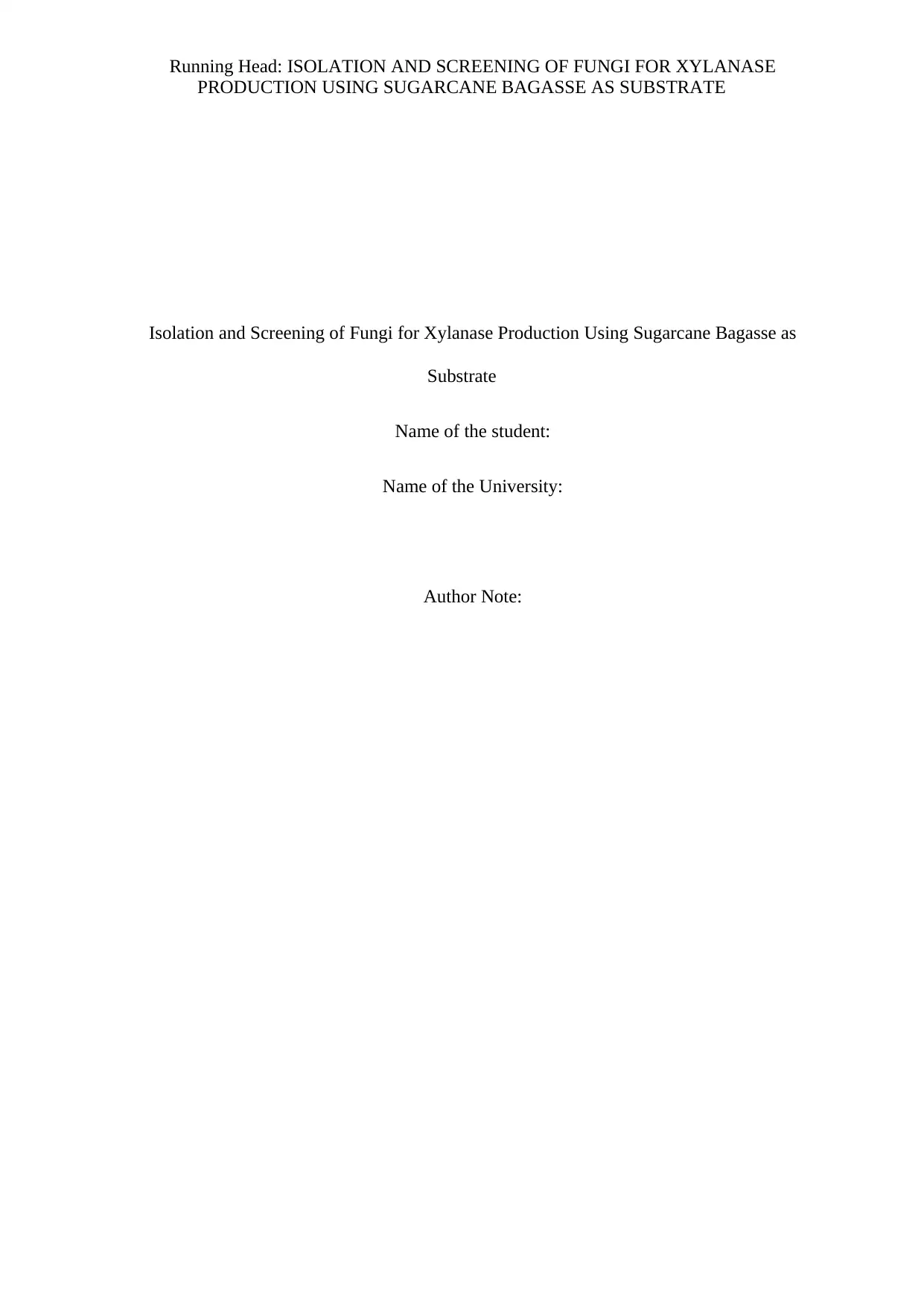
Running Head: ISOLATION AND SCREENING OF FUNGI FOR XYLANASE
PRODUCTION USING SUGARCANE BAGASSE AS SUBSTRATE
Isolation and Screening of Fungi for Xylanase Production Using Sugarcane Bagasse as
Substrate
Name of the student:
Name of the University:
Author Note:
PRODUCTION USING SUGARCANE BAGASSE AS SUBSTRATE
Isolation and Screening of Fungi for Xylanase Production Using Sugarcane Bagasse as
Substrate
Name of the student:
Name of the University:
Author Note:
Paraphrase This Document
Need a fresh take? Get an instant paraphrase of this document with our AI Paraphraser
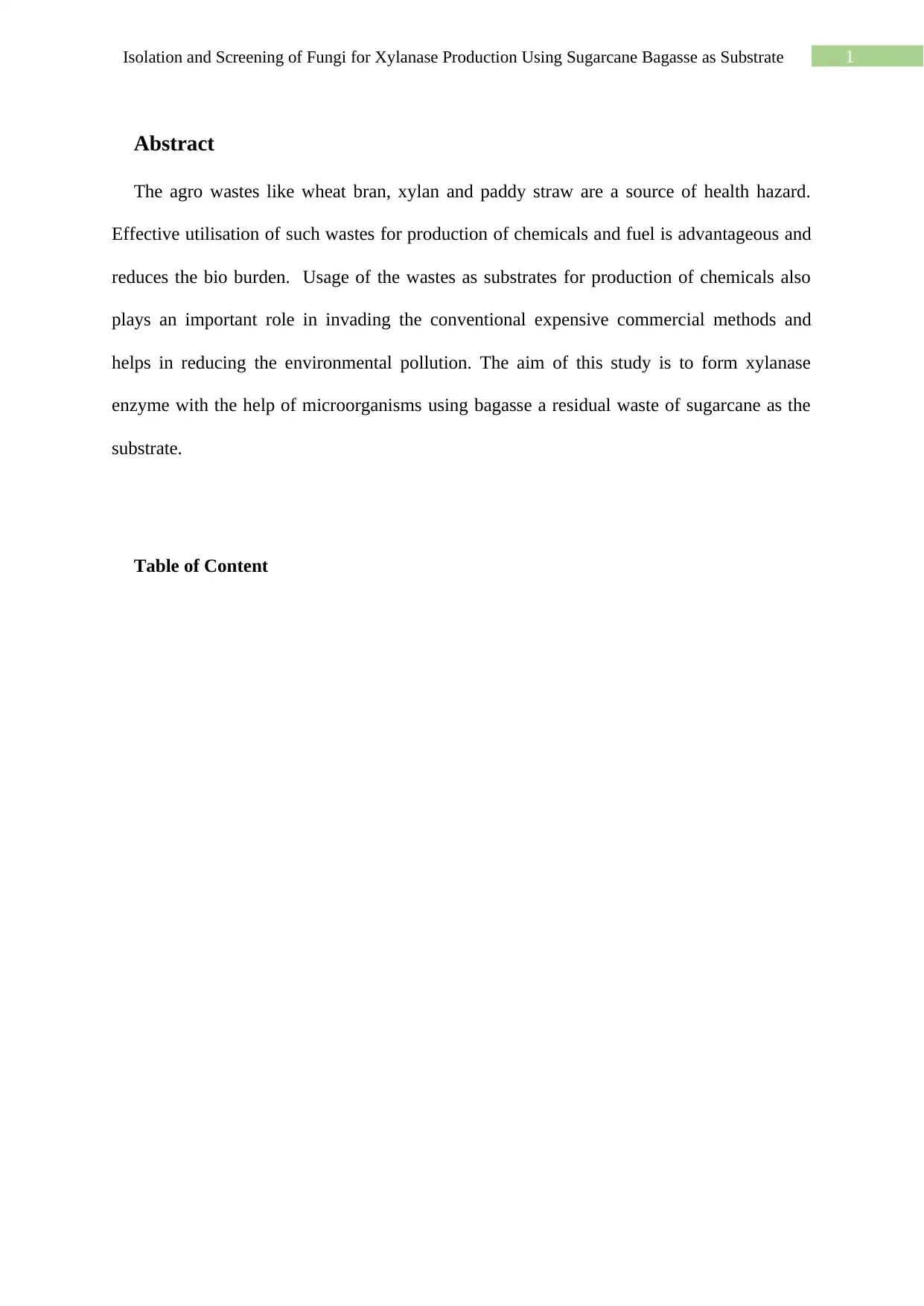
1Isolation and Screening of Fungi for Xylanase Production Using Sugarcane Bagasse as Substrate
Abstract
The agro wastes like wheat bran, xylan and paddy straw are a source of health hazard.
Effective utilisation of such wastes for production of chemicals and fuel is advantageous and
reduces the bio burden. Usage of the wastes as substrates for production of chemicals also
plays an important role in invading the conventional expensive commercial methods and
helps in reducing the environmental pollution. The aim of this study is to form xylanase
enzyme with the help of microorganisms using bagasse a residual waste of sugarcane as the
substrate.
Table of Content
Abstract
The agro wastes like wheat bran, xylan and paddy straw are a source of health hazard.
Effective utilisation of such wastes for production of chemicals and fuel is advantageous and
reduces the bio burden. Usage of the wastes as substrates for production of chemicals also
plays an important role in invading the conventional expensive commercial methods and
helps in reducing the environmental pollution. The aim of this study is to form xylanase
enzyme with the help of microorganisms using bagasse a residual waste of sugarcane as the
substrate.
Table of Content
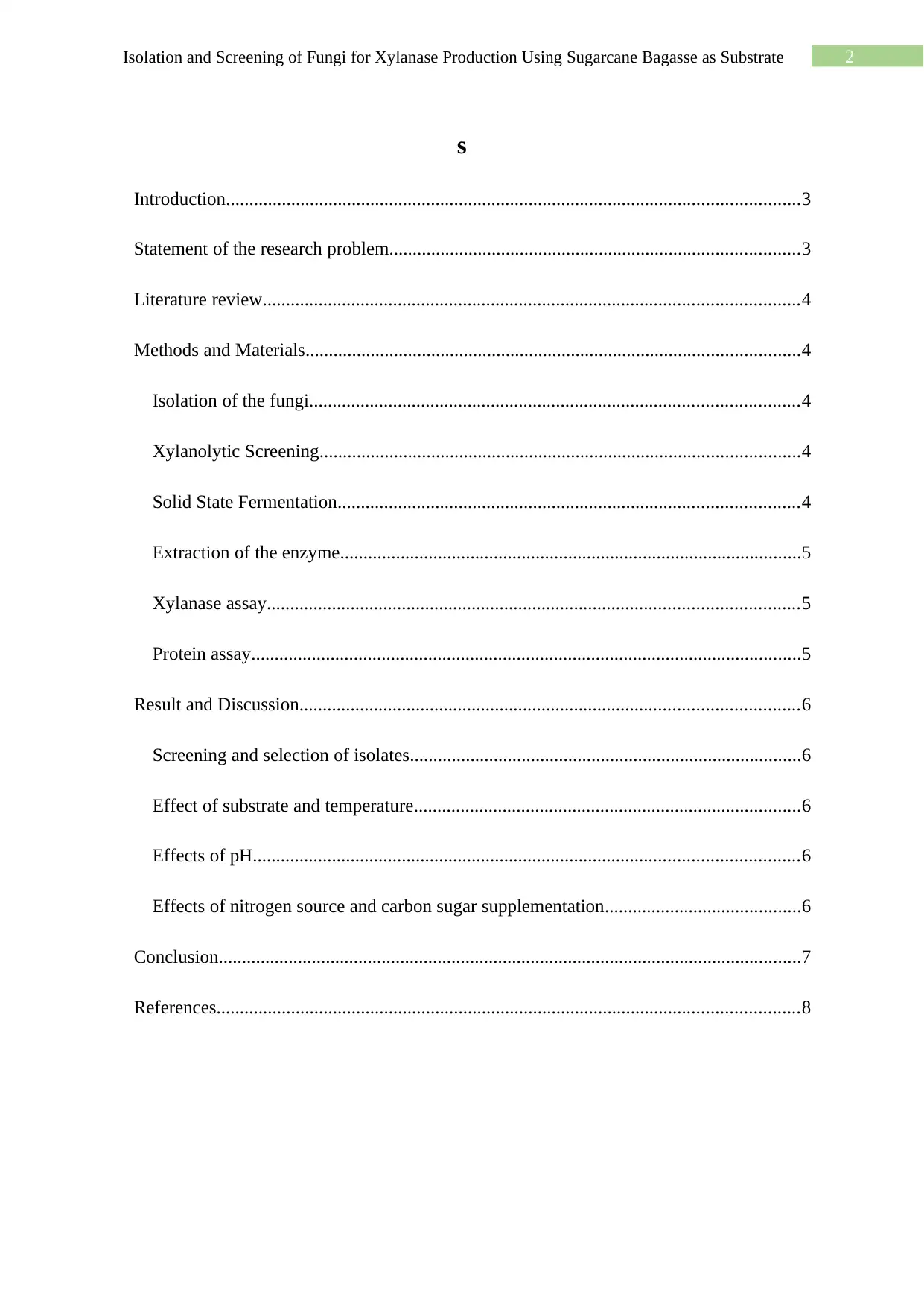
2Isolation and Screening of Fungi for Xylanase Production Using Sugarcane Bagasse as Substrate
s
Introduction...........................................................................................................................3
Statement of the research problem........................................................................................3
Literature review...................................................................................................................4
Methods and Materials..........................................................................................................4
Isolation of the fungi.........................................................................................................4
Xylanolytic Screening.......................................................................................................4
Solid State Fermentation...................................................................................................4
Extraction of the enzyme...................................................................................................5
Xylanase assay..................................................................................................................5
Protein assay......................................................................................................................5
Result and Discussion...........................................................................................................6
Screening and selection of isolates....................................................................................6
Effect of substrate and temperature...................................................................................6
Effects of pH.....................................................................................................................6
Effects of nitrogen source and carbon sugar supplementation..........................................6
Conclusion.............................................................................................................................7
References.............................................................................................................................8
s
Introduction...........................................................................................................................3
Statement of the research problem........................................................................................3
Literature review...................................................................................................................4
Methods and Materials..........................................................................................................4
Isolation of the fungi.........................................................................................................4
Xylanolytic Screening.......................................................................................................4
Solid State Fermentation...................................................................................................4
Extraction of the enzyme...................................................................................................5
Xylanase assay..................................................................................................................5
Protein assay......................................................................................................................5
Result and Discussion...........................................................................................................6
Screening and selection of isolates....................................................................................6
Effect of substrate and temperature...................................................................................6
Effects of pH.....................................................................................................................6
Effects of nitrogen source and carbon sugar supplementation..........................................6
Conclusion.............................................................................................................................7
References.............................................................................................................................8
⊘ This is a preview!⊘
Do you want full access?
Subscribe today to unlock all pages.

Trusted by 1+ million students worldwide
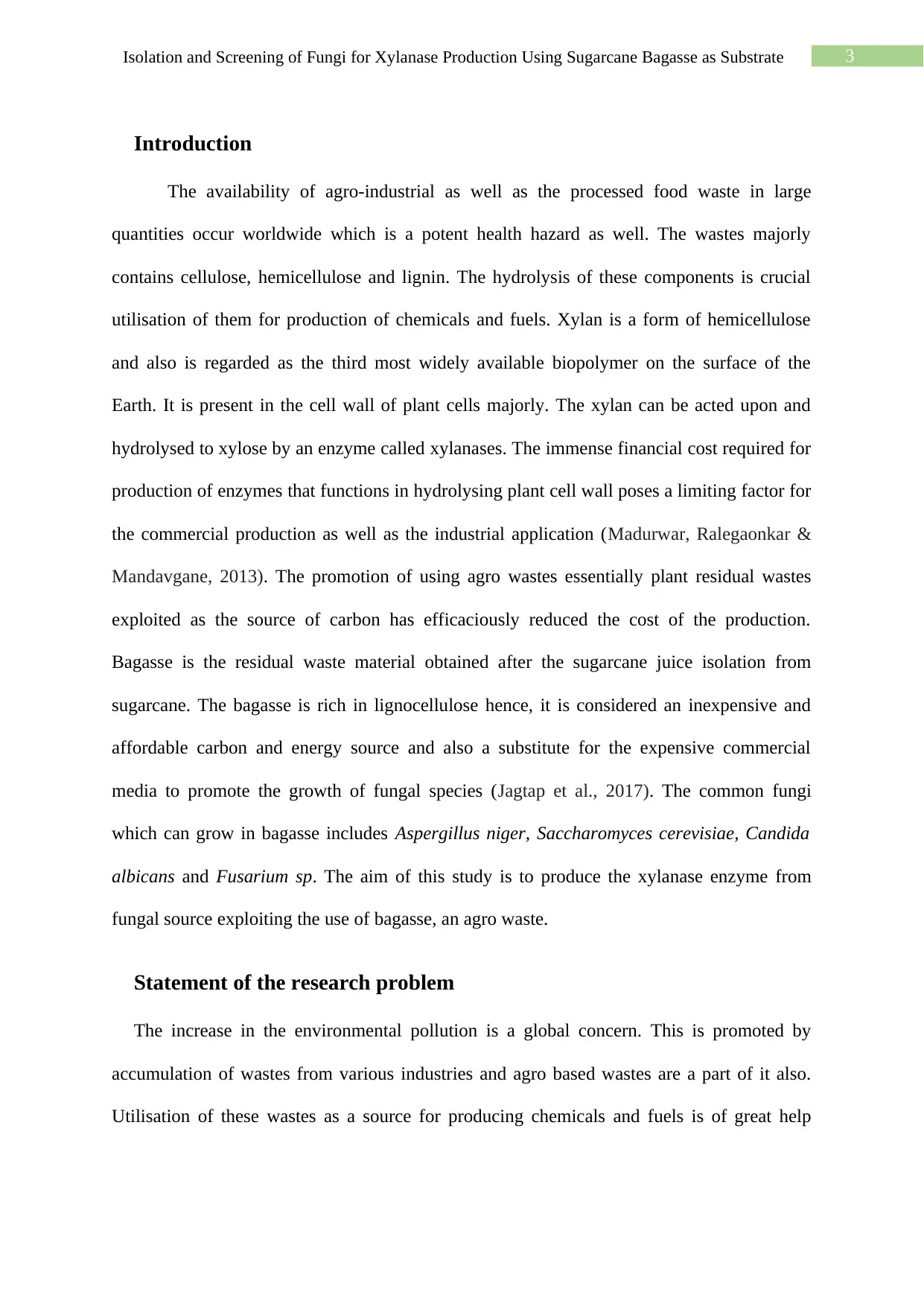
3Isolation and Screening of Fungi for Xylanase Production Using Sugarcane Bagasse as Substrate
Introduction
The availability of agro-industrial as well as the processed food waste in large
quantities occur worldwide which is a potent health hazard as well. The wastes majorly
contains cellulose, hemicellulose and lignin. The hydrolysis of these components is crucial
utilisation of them for production of chemicals and fuels. Xylan is a form of hemicellulose
and also is regarded as the third most widely available biopolymer on the surface of the
Earth. It is present in the cell wall of plant cells majorly. The xylan can be acted upon and
hydrolysed to xylose by an enzyme called xylanases. The immense financial cost required for
production of enzymes that functions in hydrolysing plant cell wall poses a limiting factor for
the commercial production as well as the industrial application (Madurwar, Ralegaonkar &
Mandavgane, 2013). The promotion of using agro wastes essentially plant residual wastes
exploited as the source of carbon has efficaciously reduced the cost of the production.
Bagasse is the residual waste material obtained after the sugarcane juice isolation from
sugarcane. The bagasse is rich in lignocellulose hence, it is considered an inexpensive and
affordable carbon and energy source and also a substitute for the expensive commercial
media to promote the growth of fungal species (Jagtap et al., 2017). The common fungi
which can grow in bagasse includes Aspergillus niger, Saccharomyces cerevisiae, Candida
albicans and Fusarium sp. The aim of this study is to produce the xylanase enzyme from
fungal source exploiting the use of bagasse, an agro waste.
Statement of the research problem
The increase in the environmental pollution is a global concern. This is promoted by
accumulation of wastes from various industries and agro based wastes are a part of it also.
Utilisation of these wastes as a source for producing chemicals and fuels is of great help
Introduction
The availability of agro-industrial as well as the processed food waste in large
quantities occur worldwide which is a potent health hazard as well. The wastes majorly
contains cellulose, hemicellulose and lignin. The hydrolysis of these components is crucial
utilisation of them for production of chemicals and fuels. Xylan is a form of hemicellulose
and also is regarded as the third most widely available biopolymer on the surface of the
Earth. It is present in the cell wall of plant cells majorly. The xylan can be acted upon and
hydrolysed to xylose by an enzyme called xylanases. The immense financial cost required for
production of enzymes that functions in hydrolysing plant cell wall poses a limiting factor for
the commercial production as well as the industrial application (Madurwar, Ralegaonkar &
Mandavgane, 2013). The promotion of using agro wastes essentially plant residual wastes
exploited as the source of carbon has efficaciously reduced the cost of the production.
Bagasse is the residual waste material obtained after the sugarcane juice isolation from
sugarcane. The bagasse is rich in lignocellulose hence, it is considered an inexpensive and
affordable carbon and energy source and also a substitute for the expensive commercial
media to promote the growth of fungal species (Jagtap et al., 2017). The common fungi
which can grow in bagasse includes Aspergillus niger, Saccharomyces cerevisiae, Candida
albicans and Fusarium sp. The aim of this study is to produce the xylanase enzyme from
fungal source exploiting the use of bagasse, an agro waste.
Statement of the research problem
The increase in the environmental pollution is a global concern. This is promoted by
accumulation of wastes from various industries and agro based wastes are a part of it also.
Utilisation of these wastes as a source for producing chemicals and fuels is of great help
Paraphrase This Document
Need a fresh take? Get an instant paraphrase of this document with our AI Paraphraser
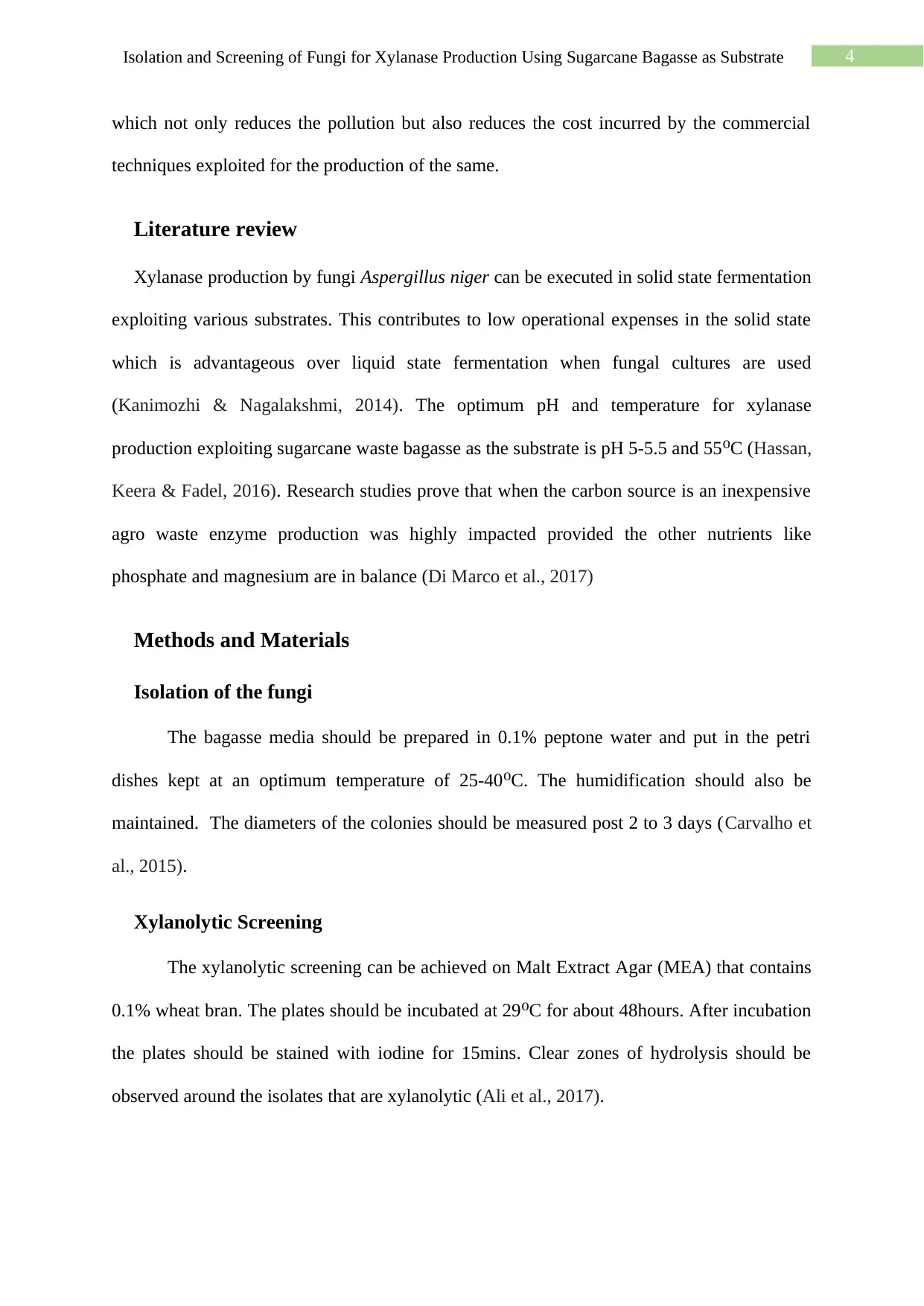
4Isolation and Screening of Fungi for Xylanase Production Using Sugarcane Bagasse as Substrate
which not only reduces the pollution but also reduces the cost incurred by the commercial
techniques exploited for the production of the same.
Literature review
Xylanase production by fungi Aspergillus niger can be executed in solid state fermentation
exploiting various substrates. This contributes to low operational expenses in the solid state
which is advantageous over liquid state fermentation when fungal cultures are used
(Kanimozhi & Nagalakshmi, 2014). The optimum pH and temperature for xylanase
production exploiting sugarcane waste bagasse as the substrate is pH 5-5.5 and 55⁰C (Hassan,
Keera & Fadel, 2016). Research studies prove that when the carbon source is an inexpensive
agro waste enzyme production was highly impacted provided the other nutrients like
phosphate and magnesium are in balance (Di Marco et al., 2017)
Methods and Materials
Isolation of the fungi
The bagasse media should be prepared in 0.1% peptone water and put in the petri
dishes kept at an optimum temperature of 25-40⁰C. The humidification should also be
maintained. The diameters of the colonies should be measured post 2 to 3 days (Carvalho et
al., 2015).
Xylanolytic Screening
The xylanolytic screening can be achieved on Malt Extract Agar (MEA) that contains
0.1% wheat bran. The plates should be incubated at 29⁰C for about 48hours. After incubation
the plates should be stained with iodine for 15mins. Clear zones of hydrolysis should be
observed around the isolates that are xylanolytic (Ali et al., 2017).
which not only reduces the pollution but also reduces the cost incurred by the commercial
techniques exploited for the production of the same.
Literature review
Xylanase production by fungi Aspergillus niger can be executed in solid state fermentation
exploiting various substrates. This contributes to low operational expenses in the solid state
which is advantageous over liquid state fermentation when fungal cultures are used
(Kanimozhi & Nagalakshmi, 2014). The optimum pH and temperature for xylanase
production exploiting sugarcane waste bagasse as the substrate is pH 5-5.5 and 55⁰C (Hassan,
Keera & Fadel, 2016). Research studies prove that when the carbon source is an inexpensive
agro waste enzyme production was highly impacted provided the other nutrients like
phosphate and magnesium are in balance (Di Marco et al., 2017)
Methods and Materials
Isolation of the fungi
The bagasse media should be prepared in 0.1% peptone water and put in the petri
dishes kept at an optimum temperature of 25-40⁰C. The humidification should also be
maintained. The diameters of the colonies should be measured post 2 to 3 days (Carvalho et
al., 2015).
Xylanolytic Screening
The xylanolytic screening can be achieved on Malt Extract Agar (MEA) that contains
0.1% wheat bran. The plates should be incubated at 29⁰C for about 48hours. After incubation
the plates should be stained with iodine for 15mins. Clear zones of hydrolysis should be
observed around the isolates that are xylanolytic (Ali et al., 2017).
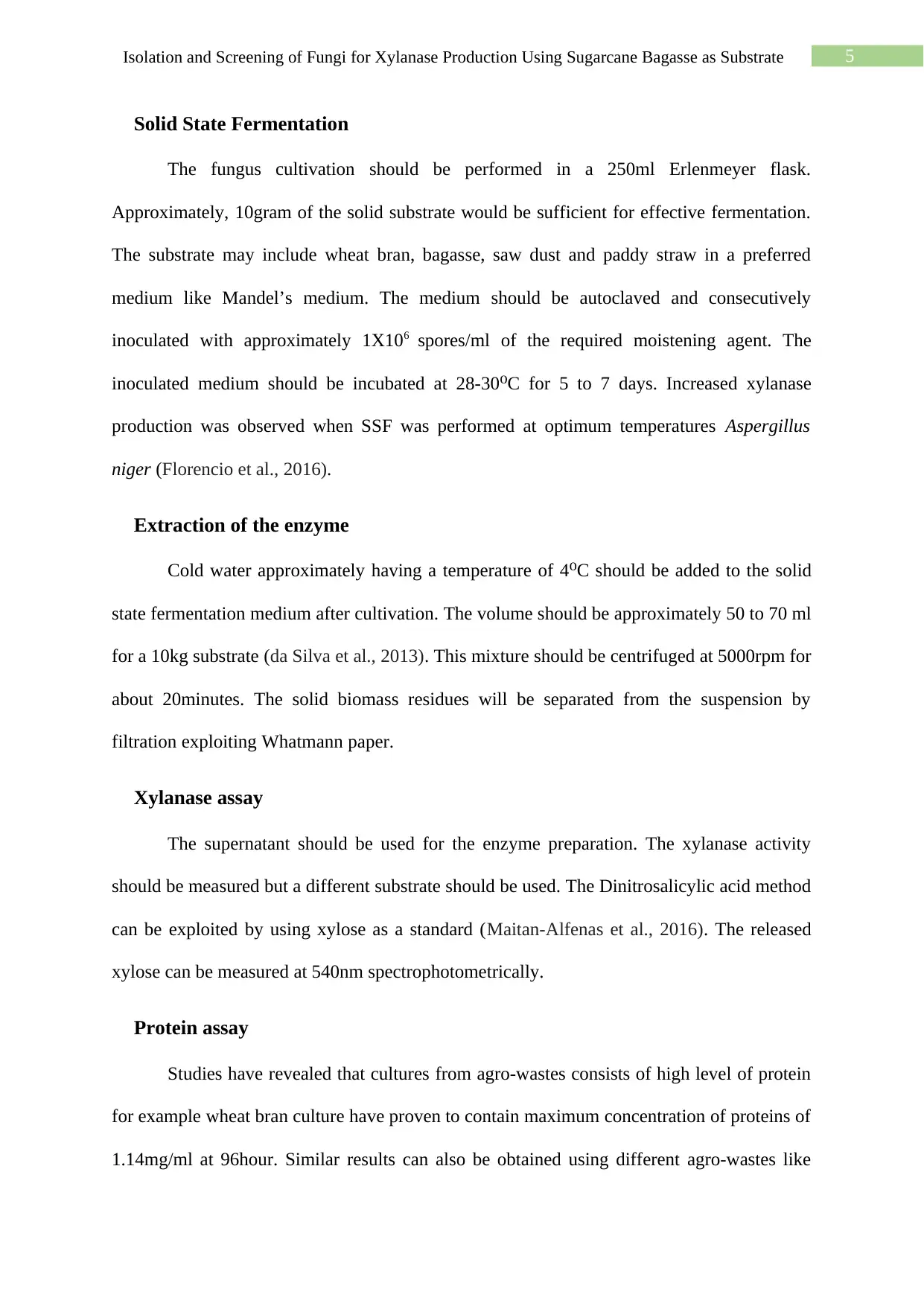
5Isolation and Screening of Fungi for Xylanase Production Using Sugarcane Bagasse as Substrate
Solid State Fermentation
The fungus cultivation should be performed in a 250ml Erlenmeyer flask.
Approximately, 10gram of the solid substrate would be sufficient for effective fermentation.
The substrate may include wheat bran, bagasse, saw dust and paddy straw in a preferred
medium like Mandel’s medium. The medium should be autoclaved and consecutively
inoculated with approximately 1X106 spores/ml of the required moistening agent. The
inoculated medium should be incubated at 28-30⁰C for 5 to 7 days. Increased xylanase
production was observed when SSF was performed at optimum temperatures Aspergillus
niger (Florencio et al., 2016).
Extraction of the enzyme
Cold water approximately having a temperature of 4⁰C should be added to the solid
state fermentation medium after cultivation. The volume should be approximately 50 to 70 ml
for a 10kg substrate (da Silva et al., 2013). This mixture should be centrifuged at 5000rpm for
about 20minutes. The solid biomass residues will be separated from the suspension by
filtration exploiting Whatmann paper.
Xylanase assay
The supernatant should be used for the enzyme preparation. The xylanase activity
should be measured but a different substrate should be used. The Dinitrosalicylic acid method
can be exploited by using xylose as a standard (Maitan-Alfenas et al., 2016). The released
xylose can be measured at 540nm spectrophotometrically.
Protein assay
Studies have revealed that cultures from agro-wastes consists of high level of protein
for example wheat bran culture have proven to contain maximum concentration of proteins of
1.14mg/ml at 96hour. Similar results can also be obtained using different agro-wastes like
Solid State Fermentation
The fungus cultivation should be performed in a 250ml Erlenmeyer flask.
Approximately, 10gram of the solid substrate would be sufficient for effective fermentation.
The substrate may include wheat bran, bagasse, saw dust and paddy straw in a preferred
medium like Mandel’s medium. The medium should be autoclaved and consecutively
inoculated with approximately 1X106 spores/ml of the required moistening agent. The
inoculated medium should be incubated at 28-30⁰C for 5 to 7 days. Increased xylanase
production was observed when SSF was performed at optimum temperatures Aspergillus
niger (Florencio et al., 2016).
Extraction of the enzyme
Cold water approximately having a temperature of 4⁰C should be added to the solid
state fermentation medium after cultivation. The volume should be approximately 50 to 70 ml
for a 10kg substrate (da Silva et al., 2013). This mixture should be centrifuged at 5000rpm for
about 20minutes. The solid biomass residues will be separated from the suspension by
filtration exploiting Whatmann paper.
Xylanase assay
The supernatant should be used for the enzyme preparation. The xylanase activity
should be measured but a different substrate should be used. The Dinitrosalicylic acid method
can be exploited by using xylose as a standard (Maitan-Alfenas et al., 2016). The released
xylose can be measured at 540nm spectrophotometrically.
Protein assay
Studies have revealed that cultures from agro-wastes consists of high level of protein
for example wheat bran culture have proven to contain maximum concentration of proteins of
1.14mg/ml at 96hour. Similar results can also be obtained using different agro-wastes like
⊘ This is a preview!⊘
Do you want full access?
Subscribe today to unlock all pages.

Trusted by 1+ million students worldwide
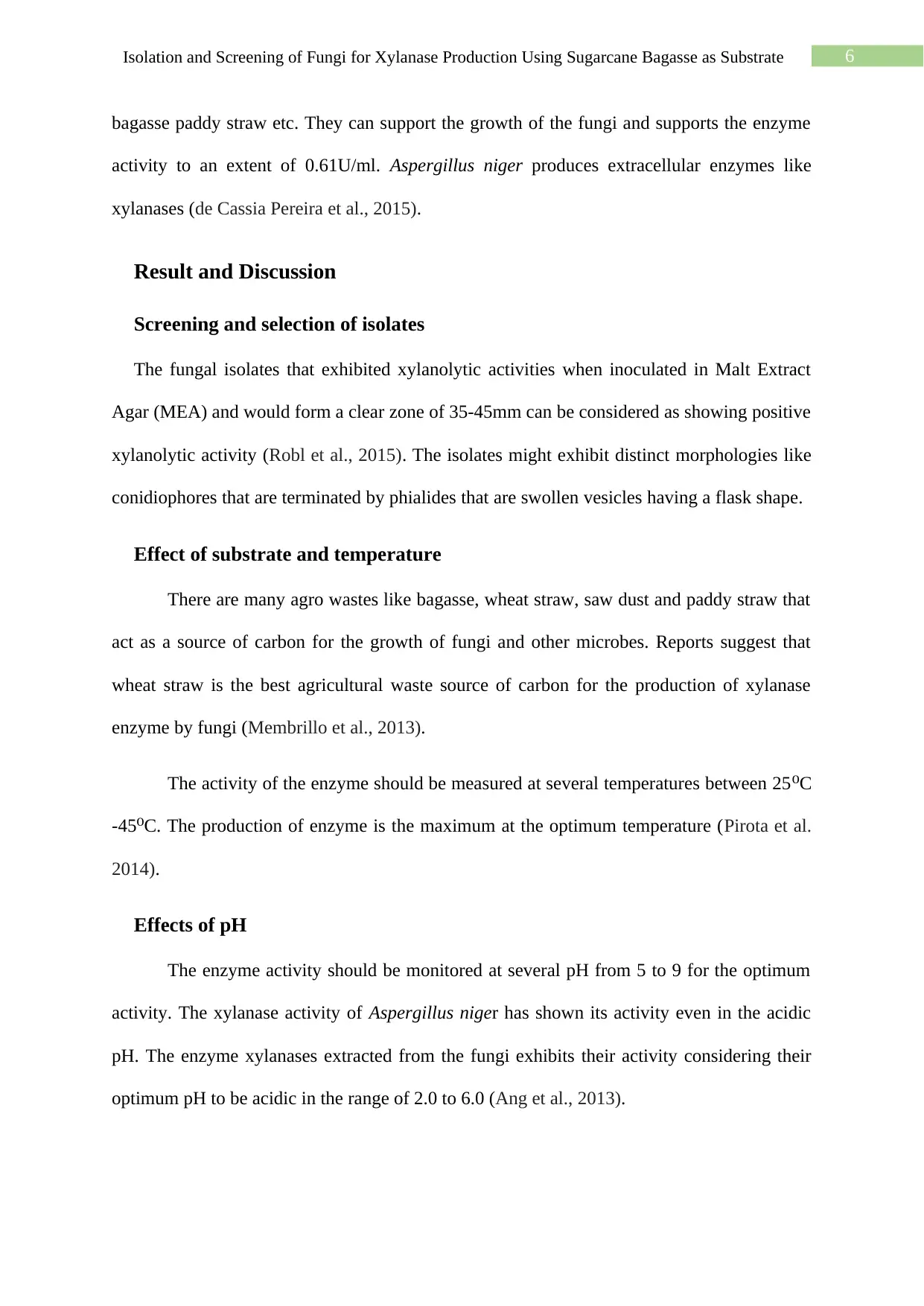
6Isolation and Screening of Fungi for Xylanase Production Using Sugarcane Bagasse as Substrate
bagasse paddy straw etc. They can support the growth of the fungi and supports the enzyme
activity to an extent of 0.61U/ml. Aspergillus niger produces extracellular enzymes like
xylanases (de Cassia Pereira et al., 2015).
Result and Discussion
Screening and selection of isolates
The fungal isolates that exhibited xylanolytic activities when inoculated in Malt Extract
Agar (MEA) and would form a clear zone of 35-45mm can be considered as showing positive
xylanolytic activity (Robl et al., 2015). The isolates might exhibit distinct morphologies like
conidiophores that are terminated by phialides that are swollen vesicles having a flask shape.
Effect of substrate and temperature
There are many agro wastes like bagasse, wheat straw, saw dust and paddy straw that
act as a source of carbon for the growth of fungi and other microbes. Reports suggest that
wheat straw is the best agricultural waste source of carbon for the production of xylanase
enzyme by fungi (Membrillo et al., 2013).
The activity of the enzyme should be measured at several temperatures between 25⁰C
-45⁰C. The production of enzyme is the maximum at the optimum temperature (Pirota et al.
2014).
Effects of pH
The enzyme activity should be monitored at several pH from 5 to 9 for the optimum
activity. The xylanase activity of Aspergillus niger has shown its activity even in the acidic
pH. The enzyme xylanases extracted from the fungi exhibits their activity considering their
optimum pH to be acidic in the range of 2.0 to 6.0 (Ang et al., 2013).
bagasse paddy straw etc. They can support the growth of the fungi and supports the enzyme
activity to an extent of 0.61U/ml. Aspergillus niger produces extracellular enzymes like
xylanases (de Cassia Pereira et al., 2015).
Result and Discussion
Screening and selection of isolates
The fungal isolates that exhibited xylanolytic activities when inoculated in Malt Extract
Agar (MEA) and would form a clear zone of 35-45mm can be considered as showing positive
xylanolytic activity (Robl et al., 2015). The isolates might exhibit distinct morphologies like
conidiophores that are terminated by phialides that are swollen vesicles having a flask shape.
Effect of substrate and temperature
There are many agro wastes like bagasse, wheat straw, saw dust and paddy straw that
act as a source of carbon for the growth of fungi and other microbes. Reports suggest that
wheat straw is the best agricultural waste source of carbon for the production of xylanase
enzyme by fungi (Membrillo et al., 2013).
The activity of the enzyme should be measured at several temperatures between 25⁰C
-45⁰C. The production of enzyme is the maximum at the optimum temperature (Pirota et al.
2014).
Effects of pH
The enzyme activity should be monitored at several pH from 5 to 9 for the optimum
activity. The xylanase activity of Aspergillus niger has shown its activity even in the acidic
pH. The enzyme xylanases extracted from the fungi exhibits their activity considering their
optimum pH to be acidic in the range of 2.0 to 6.0 (Ang et al., 2013).
Paraphrase This Document
Need a fresh take? Get an instant paraphrase of this document with our AI Paraphraser
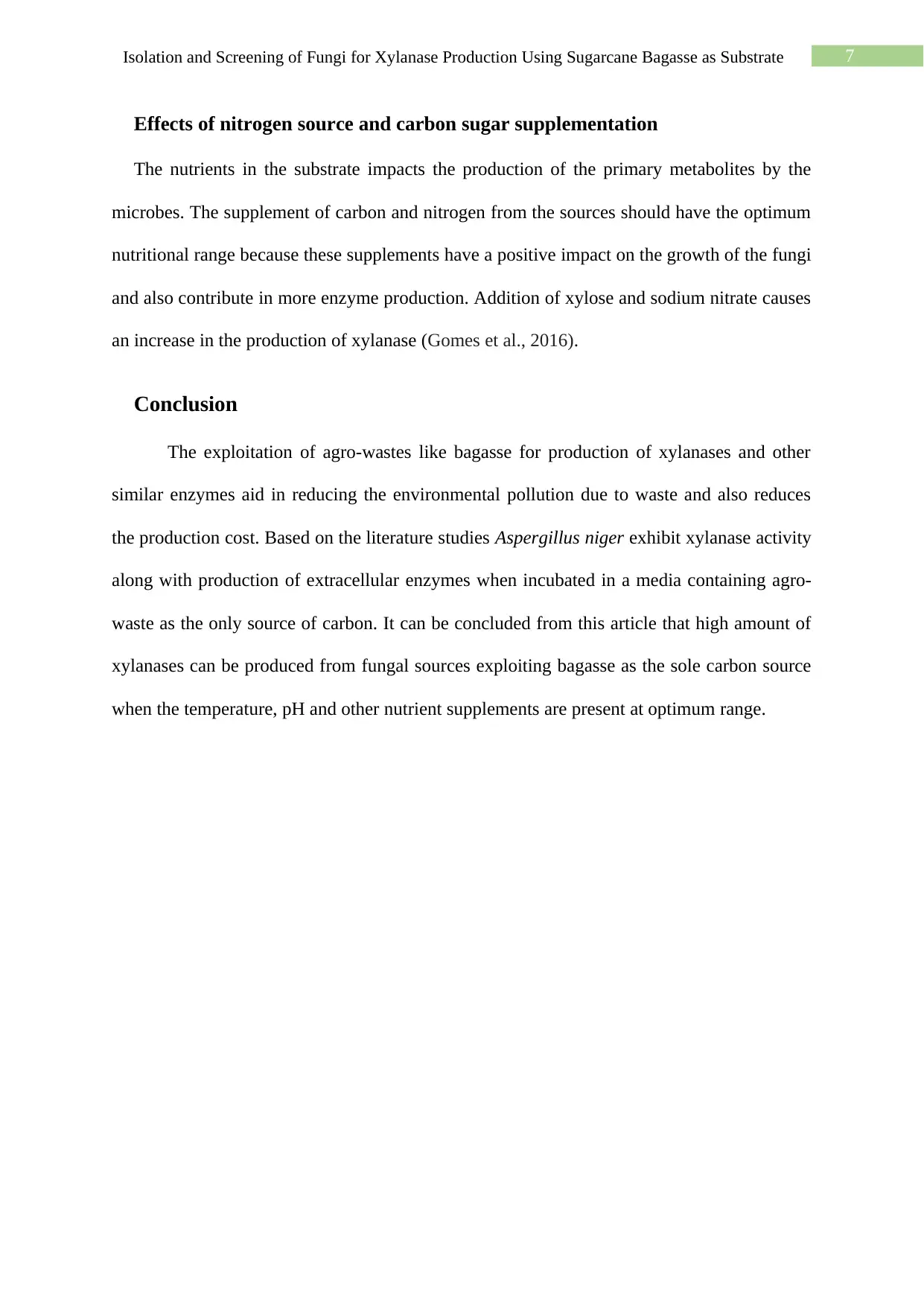
7Isolation and Screening of Fungi for Xylanase Production Using Sugarcane Bagasse as Substrate
Effects of nitrogen source and carbon sugar supplementation
The nutrients in the substrate impacts the production of the primary metabolites by the
microbes. The supplement of carbon and nitrogen from the sources should have the optimum
nutritional range because these supplements have a positive impact on the growth of the fungi
and also contribute in more enzyme production. Addition of xylose and sodium nitrate causes
an increase in the production of xylanase (Gomes et al., 2016).
Conclusion
The exploitation of agro-wastes like bagasse for production of xylanases and other
similar enzymes aid in reducing the environmental pollution due to waste and also reduces
the production cost. Based on the literature studies Aspergillus niger exhibit xylanase activity
along with production of extracellular enzymes when incubated in a media containing agro-
waste as the only source of carbon. It can be concluded from this article that high amount of
xylanases can be produced from fungal sources exploiting bagasse as the sole carbon source
when the temperature, pH and other nutrient supplements are present at optimum range.
Effects of nitrogen source and carbon sugar supplementation
The nutrients in the substrate impacts the production of the primary metabolites by the
microbes. The supplement of carbon and nitrogen from the sources should have the optimum
nutritional range because these supplements have a positive impact on the growth of the fungi
and also contribute in more enzyme production. Addition of xylose and sodium nitrate causes
an increase in the production of xylanase (Gomes et al., 2016).
Conclusion
The exploitation of agro-wastes like bagasse for production of xylanases and other
similar enzymes aid in reducing the environmental pollution due to waste and also reduces
the production cost. Based on the literature studies Aspergillus niger exhibit xylanase activity
along with production of extracellular enzymes when incubated in a media containing agro-
waste as the only source of carbon. It can be concluded from this article that high amount of
xylanases can be produced from fungal sources exploiting bagasse as the sole carbon source
when the temperature, pH and other nutrient supplements are present at optimum range.
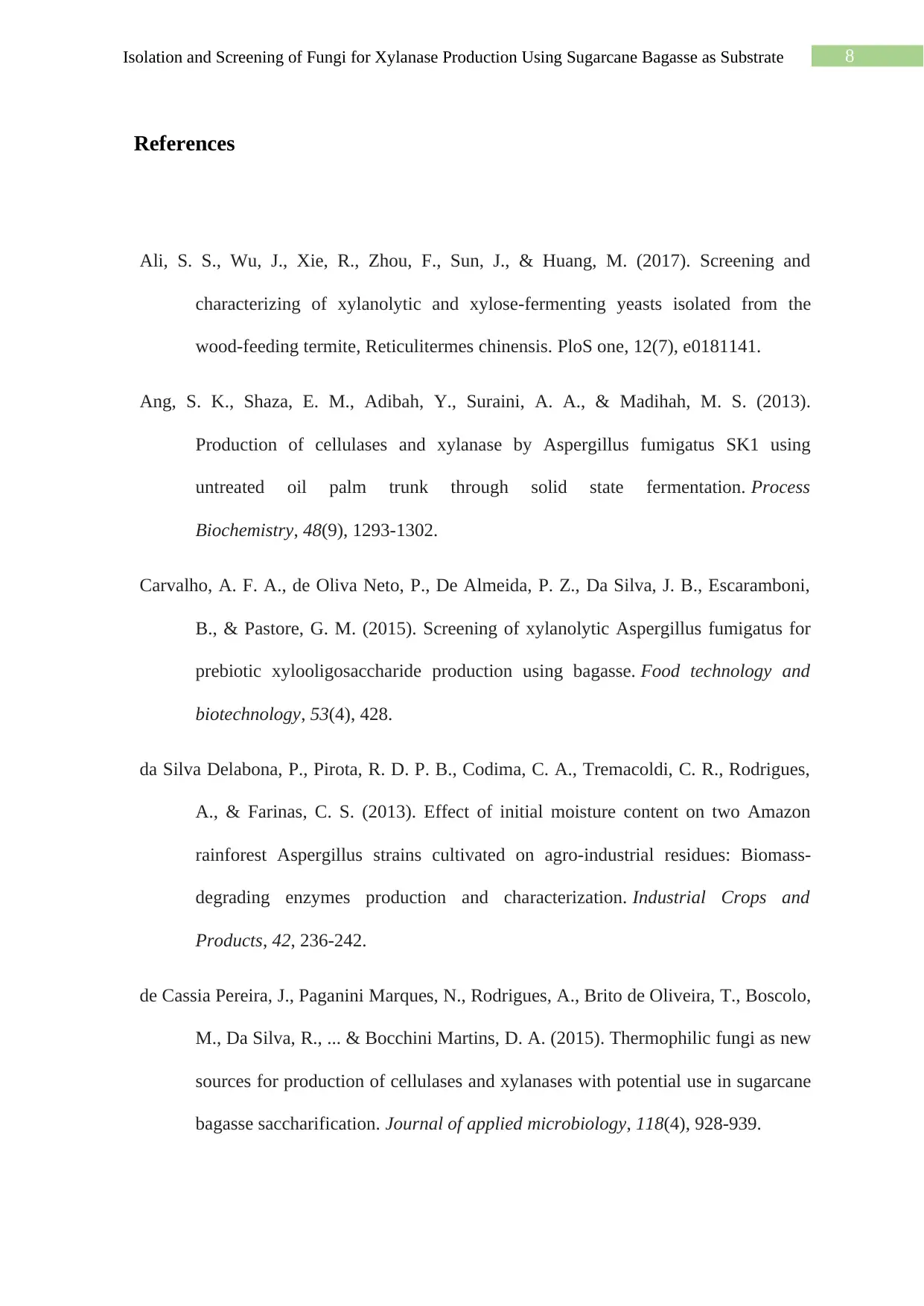
8Isolation and Screening of Fungi for Xylanase Production Using Sugarcane Bagasse as Substrate
References
Ali, S. S., Wu, J., Xie, R., Zhou, F., Sun, J., & Huang, M. (2017). Screening and
characterizing of xylanolytic and xylose-fermenting yeasts isolated from the
wood-feeding termite, Reticulitermes chinensis. PloS one, 12(7), e0181141.
Ang, S. K., Shaza, E. M., Adibah, Y., Suraini, A. A., & Madihah, M. S. (2013).
Production of cellulases and xylanase by Aspergillus fumigatus SK1 using
untreated oil palm trunk through solid state fermentation. Process
Biochemistry, 48(9), 1293-1302.
Carvalho, A. F. A., de Oliva Neto, P., De Almeida, P. Z., Da Silva, J. B., Escaramboni,
B., & Pastore, G. M. (2015). Screening of xylanolytic Aspergillus fumigatus for
prebiotic xylooligosaccharide production using bagasse. Food technology and
biotechnology, 53(4), 428.
da Silva Delabona, P., Pirota, R. D. P. B., Codima, C. A., Tremacoldi, C. R., Rodrigues,
A., & Farinas, C. S. (2013). Effect of initial moisture content on two Amazon
rainforest Aspergillus strains cultivated on agro-industrial residues: Biomass-
degrading enzymes production and characterization. Industrial Crops and
Products, 42, 236-242.
de Cassia Pereira, J., Paganini Marques, N., Rodrigues, A., Brito de Oliveira, T., Boscolo,
M., Da Silva, R., ... & Bocchini Martins, D. A. (2015). Thermophilic fungi as new
sources for production of cellulases and xylanases with potential use in sugarcane
bagasse saccharification. Journal of applied microbiology, 118(4), 928-939.
References
Ali, S. S., Wu, J., Xie, R., Zhou, F., Sun, J., & Huang, M. (2017). Screening and
characterizing of xylanolytic and xylose-fermenting yeasts isolated from the
wood-feeding termite, Reticulitermes chinensis. PloS one, 12(7), e0181141.
Ang, S. K., Shaza, E. M., Adibah, Y., Suraini, A. A., & Madihah, M. S. (2013).
Production of cellulases and xylanase by Aspergillus fumigatus SK1 using
untreated oil palm trunk through solid state fermentation. Process
Biochemistry, 48(9), 1293-1302.
Carvalho, A. F. A., de Oliva Neto, P., De Almeida, P. Z., Da Silva, J. B., Escaramboni,
B., & Pastore, G. M. (2015). Screening of xylanolytic Aspergillus fumigatus for
prebiotic xylooligosaccharide production using bagasse. Food technology and
biotechnology, 53(4), 428.
da Silva Delabona, P., Pirota, R. D. P. B., Codima, C. A., Tremacoldi, C. R., Rodrigues,
A., & Farinas, C. S. (2013). Effect of initial moisture content on two Amazon
rainforest Aspergillus strains cultivated on agro-industrial residues: Biomass-
degrading enzymes production and characterization. Industrial Crops and
Products, 42, 236-242.
de Cassia Pereira, J., Paganini Marques, N., Rodrigues, A., Brito de Oliveira, T., Boscolo,
M., Da Silva, R., ... & Bocchini Martins, D. A. (2015). Thermophilic fungi as new
sources for production of cellulases and xylanases with potential use in sugarcane
bagasse saccharification. Journal of applied microbiology, 118(4), 928-939.
⊘ This is a preview!⊘
Do you want full access?
Subscribe today to unlock all pages.

Trusted by 1+ million students worldwide
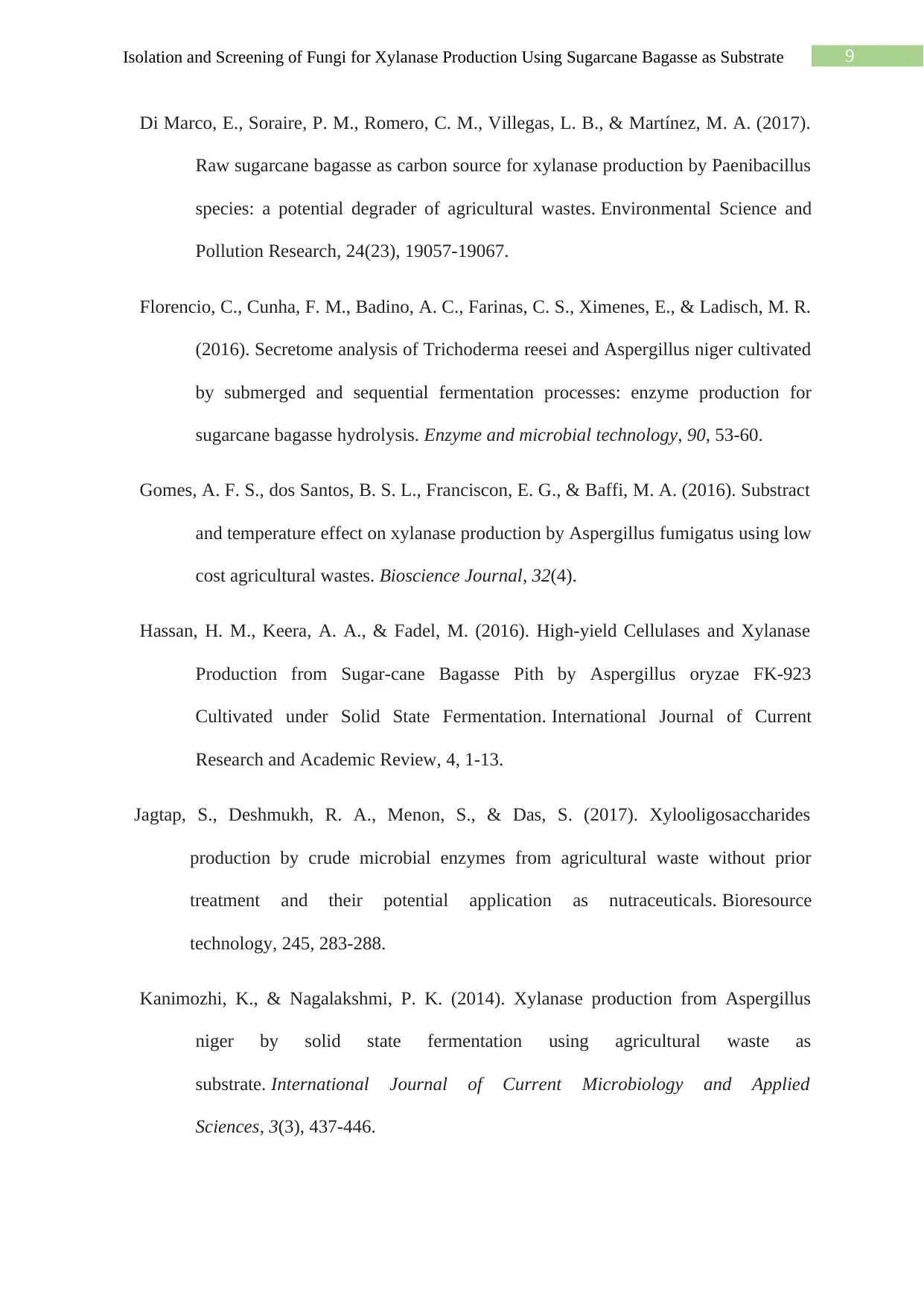
9Isolation and Screening of Fungi for Xylanase Production Using Sugarcane Bagasse as Substrate
Di Marco, E., Soraire, P. M., Romero, C. M., Villegas, L. B., & Martínez, M. A. (2017).
Raw sugarcane bagasse as carbon source for xylanase production by Paenibacillus
species: a potential degrader of agricultural wastes. Environmental Science and
Pollution Research, 24(23), 19057-19067.
Florencio, C., Cunha, F. M., Badino, A. C., Farinas, C. S., Ximenes, E., & Ladisch, M. R.
(2016). Secretome analysis of Trichoderma reesei and Aspergillus niger cultivated
by submerged and sequential fermentation processes: enzyme production for
sugarcane bagasse hydrolysis. Enzyme and microbial technology, 90, 53-60.
Gomes, A. F. S., dos Santos, B. S. L., Franciscon, E. G., & Baffi, M. A. (2016). Substract
and temperature effect on xylanase production by Aspergillus fumigatus using low
cost agricultural wastes. Bioscience Journal, 32(4).
Hassan, H. M., Keera, A. A., & Fadel, M. (2016). High-yield Cellulases and Xylanase
Production from Sugar-cane Bagasse Pith by Aspergillus oryzae FK-923
Cultivated under Solid State Fermentation. International Journal of Current
Research and Academic Review, 4, 1-13.
Jagtap, S., Deshmukh, R. A., Menon, S., & Das, S. (2017). Xylooligosaccharides
production by crude microbial enzymes from agricultural waste without prior
treatment and their potential application as nutraceuticals. Bioresource
technology, 245, 283-288.
Kanimozhi, K., & Nagalakshmi, P. K. (2014). Xylanase production from Aspergillus
niger by solid state fermentation using agricultural waste as
substrate. International Journal of Current Microbiology and Applied
Sciences, 3(3), 437-446.
Di Marco, E., Soraire, P. M., Romero, C. M., Villegas, L. B., & Martínez, M. A. (2017).
Raw sugarcane bagasse as carbon source for xylanase production by Paenibacillus
species: a potential degrader of agricultural wastes. Environmental Science and
Pollution Research, 24(23), 19057-19067.
Florencio, C., Cunha, F. M., Badino, A. C., Farinas, C. S., Ximenes, E., & Ladisch, M. R.
(2016). Secretome analysis of Trichoderma reesei and Aspergillus niger cultivated
by submerged and sequential fermentation processes: enzyme production for
sugarcane bagasse hydrolysis. Enzyme and microbial technology, 90, 53-60.
Gomes, A. F. S., dos Santos, B. S. L., Franciscon, E. G., & Baffi, M. A. (2016). Substract
and temperature effect on xylanase production by Aspergillus fumigatus using low
cost agricultural wastes. Bioscience Journal, 32(4).
Hassan, H. M., Keera, A. A., & Fadel, M. (2016). High-yield Cellulases and Xylanase
Production from Sugar-cane Bagasse Pith by Aspergillus oryzae FK-923
Cultivated under Solid State Fermentation. International Journal of Current
Research and Academic Review, 4, 1-13.
Jagtap, S., Deshmukh, R. A., Menon, S., & Das, S. (2017). Xylooligosaccharides
production by crude microbial enzymes from agricultural waste without prior
treatment and their potential application as nutraceuticals. Bioresource
technology, 245, 283-288.
Kanimozhi, K., & Nagalakshmi, P. K. (2014). Xylanase production from Aspergillus
niger by solid state fermentation using agricultural waste as
substrate. International Journal of Current Microbiology and Applied
Sciences, 3(3), 437-446.
Paraphrase This Document
Need a fresh take? Get an instant paraphrase of this document with our AI Paraphraser
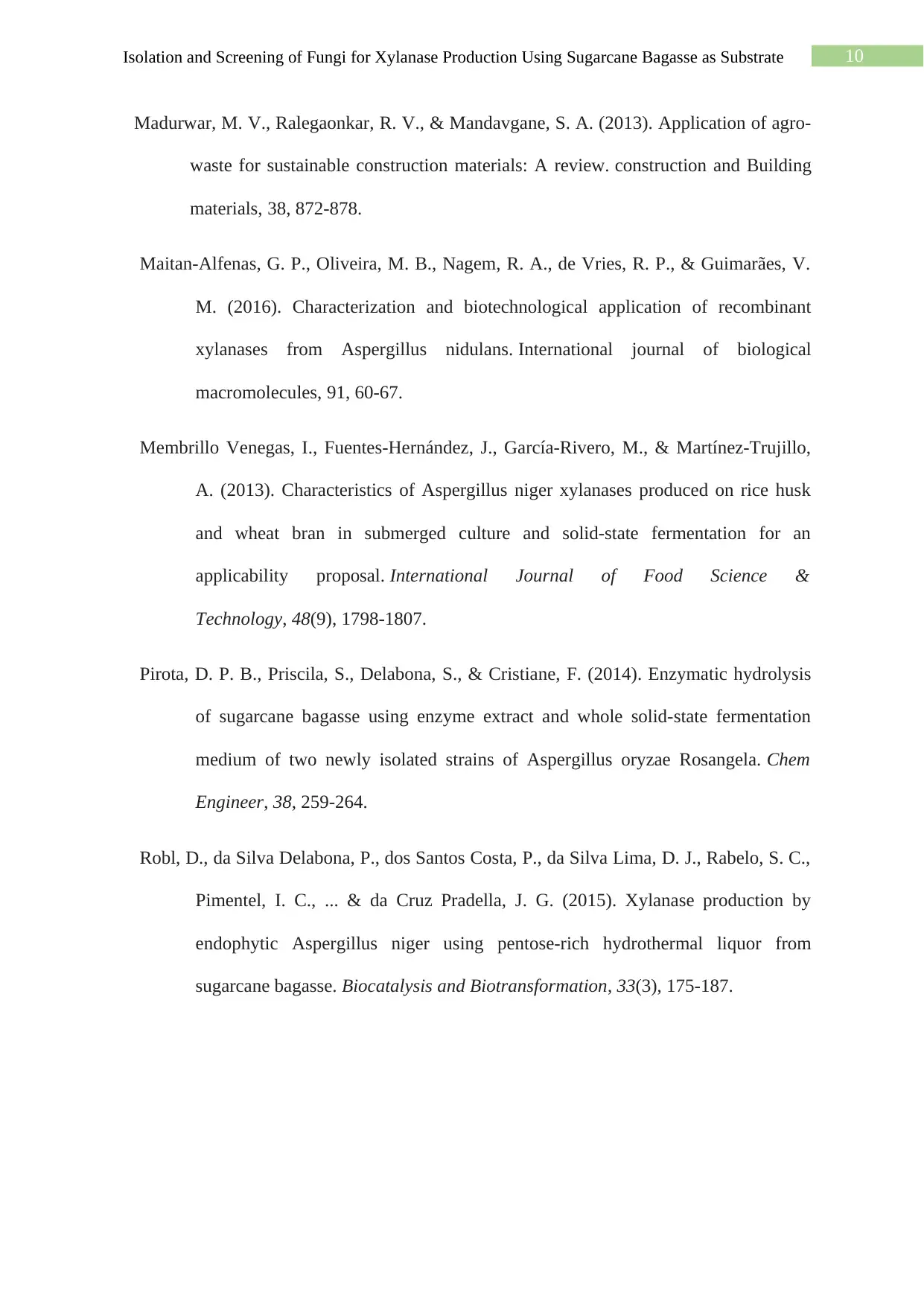
10Isolation and Screening of Fungi for Xylanase Production Using Sugarcane Bagasse as Substrate
Madurwar, M. V., Ralegaonkar, R. V., & Mandavgane, S. A. (2013). Application of agro-
waste for sustainable construction materials: A review. construction and Building
materials, 38, 872-878.
Maitan-Alfenas, G. P., Oliveira, M. B., Nagem, R. A., de Vries, R. P., & Guimarães, V.
M. (2016). Characterization and biotechnological application of recombinant
xylanases from Aspergillus nidulans. International journal of biological
macromolecules, 91, 60-67.
Membrillo Venegas, I., Fuentes‐Hernández, J., García‐Rivero, M., & Martínez‐Trujillo,
A. (2013). Characteristics of Aspergillus niger xylanases produced on rice husk
and wheat bran in submerged culture and solid‐state fermentation for an
applicability proposal. International Journal of Food Science &
Technology, 48(9), 1798-1807.
Pirota, D. P. B., Priscila, S., Delabona, S., & Cristiane, F. (2014). Enzymatic hydrolysis
of sugarcane bagasse using enzyme extract and whole solid-state fermentation
medium of two newly isolated strains of Aspergillus oryzae Rosangela. Chem
Engineer, 38, 259-264.
Robl, D., da Silva Delabona, P., dos Santos Costa, P., da Silva Lima, D. J., Rabelo, S. C.,
Pimentel, I. C., ... & da Cruz Pradella, J. G. (2015). Xylanase production by
endophytic Aspergillus niger using pentose-rich hydrothermal liquor from
sugarcane bagasse. Biocatalysis and Biotransformation, 33(3), 175-187.
Madurwar, M. V., Ralegaonkar, R. V., & Mandavgane, S. A. (2013). Application of agro-
waste for sustainable construction materials: A review. construction and Building
materials, 38, 872-878.
Maitan-Alfenas, G. P., Oliveira, M. B., Nagem, R. A., de Vries, R. P., & Guimarães, V.
M. (2016). Characterization and biotechnological application of recombinant
xylanases from Aspergillus nidulans. International journal of biological
macromolecules, 91, 60-67.
Membrillo Venegas, I., Fuentes‐Hernández, J., García‐Rivero, M., & Martínez‐Trujillo,
A. (2013). Characteristics of Aspergillus niger xylanases produced on rice husk
and wheat bran in submerged culture and solid‐state fermentation for an
applicability proposal. International Journal of Food Science &
Technology, 48(9), 1798-1807.
Pirota, D. P. B., Priscila, S., Delabona, S., & Cristiane, F. (2014). Enzymatic hydrolysis
of sugarcane bagasse using enzyme extract and whole solid-state fermentation
medium of two newly isolated strains of Aspergillus oryzae Rosangela. Chem
Engineer, 38, 259-264.
Robl, D., da Silva Delabona, P., dos Santos Costa, P., da Silva Lima, D. J., Rabelo, S. C.,
Pimentel, I. C., ... & da Cruz Pradella, J. G. (2015). Xylanase production by
endophytic Aspergillus niger using pentose-rich hydrothermal liquor from
sugarcane bagasse. Biocatalysis and Biotransformation, 33(3), 175-187.
1 out of 11
Your All-in-One AI-Powered Toolkit for Academic Success.
+13062052269
info@desklib.com
Available 24*7 on WhatsApp / Email
![[object Object]](/_next/static/media/star-bottom.7253800d.svg)
Unlock your academic potential
Copyright © 2020–2025 A2Z Services. All Rights Reserved. Developed and managed by ZUCOL.
